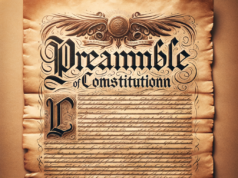Table of Contents
- 1 Understanding the Current Landscape of Legislative Authority Challenges
- 2 Historical Context: The Evolution of Legislative Powers and Limitations
- 3 Key Factors Contributing to the Erosion of Legislative Authority Today
- 4 Case Studies: Notable Instances of Legislative Authority Conflicts
- 5 Proposed Solutions: Strengthening Legislative Authority in Modern Governance
- 6 The Future of Legislative Authority: Trends and Predictions for Reform

In recent years, the landscape of legislative authority has faced unprecedented challenges, raising critical questions about the balance of power within government systems. As various branches of government grapple with their roles and responsibilities, the erosion of legislative authority has become a pressing concern for policymakers, scholars, and citizens alike. This article delves into the current challenges facing legislative bodies, explores historical contexts, identifies key factors contributing to these issues, examines notable case studies, proposes potential solutions, and offers predictions for the future of legislative authority in modern governance.
Understanding the Current Landscape of Legislative Authority Challenges
Today, legislative bodies worldwide are confronting a myriad of challenges that threaten their authority and effectiveness. The rise of executive power, often justified by national emergencies or crises, has led to a significant shift in the balance of power, with many legislatures finding themselves sidelined in crucial decision-making processes. Additionally, the increasing complexity of global issues, such as climate change and public health crises, has necessitated swift action, often at the expense of thorough legislative debate and scrutiny. The proliferation of partisan politics further complicates the landscape, as polarization can lead to legislative gridlock, undermining the ability of elected representatives to fulfill their constitutional roles. As a result, the legitimacy and effectiveness of legislative authority are increasingly called into question.
Historical Context: The Evolution of Legislative Powers and Limitations
The evolution of legislative authority can be traced back to the foundations of democratic governance, where the separation of powers was established to prevent the concentration of authority in any single branch of government. Historically, legislatures were seen as the embodiment of the people’s will, tasked with enacting laws and overseeing the executive branch. However, over time, various factors, including wars, economic crises, and social movements, have led to shifts in power dynamics. For instance, during times of war, executive powers have often expanded, leading to temporary or permanent changes in legislative authority. The historical context reveals a pattern of ebb and flow in legislative powers, shaped by both internal and external pressures, which continues to influence contemporary governance.
Key Factors Contributing to the Erosion of Legislative Authority Today
Several key factors contribute to the ongoing erosion of legislative authority in modern governance. First, the rise of executive orders and decrees allows leaders to bypass legislative processes, undermining the role of elected representatives. Second, the increasing influence of special interest groups and lobbyists can skew legislative priorities, making it challenging for lawmakers to act in the public interest. Third, the rapid pace of technological change and globalization has created complex issues that often require immediate action, leading to a preference for executive solutions over deliberative legislative processes. Finally, the growing polarization within political parties has resulted in a lack of cooperation and compromise, further weakening the legislative branch’s ability to function effectively.
Case Studies: Notable Instances of Legislative Authority Conflicts
Several notable instances illustrate the conflicts surrounding legislative authority in recent years. One prominent example is the U.S. Congress’s struggle to assert its authority in the face of executive actions taken during the COVID-19 pandemic. The rapid implementation of emergency measures by the executive branch raised concerns about the bypassing of legislative oversight. Similarly, in countries like Hungary and Poland, governments have enacted laws that undermine the powers of their respective parliaments, raising alarms about the erosion of democratic norms. These case studies highlight the critical need for vigilance and advocacy to protect legislative authority against encroachments from the executive branch and other forces.
Proposed Solutions: Strengthening Legislative Authority in Modern Governance
To address the challenges facing legislative authority, several solutions have been proposed. First, enhancing transparency and accountability within the legislative process can help restore public trust and engagement. This could involve implementing measures such as public hearings, increased access to legislative documents, and the use of technology to facilitate citizen participation. Second, reforming campaign finance laws to reduce the influence of special interest groups can empower legislators to prioritize the needs of their constituents. Third, fostering bipartisan collaboration and dialogue can help break the cycle of polarization, enabling lawmakers to work together on pressing issues. Finally, establishing clear guidelines for the use of executive power can help ensure that legislative authority is not unduly undermined during times of crisis.
The Future of Legislative Authority: Trends and Predictions for Reform
Looking ahead, the future of legislative authority will likely be shaped by ongoing debates about the balance of power and the role of government in addressing complex societal challenges. As citizens increasingly demand accountability and responsiveness from their elected representatives, there may be a renewed focus on legislative reform. Trends such as the rise of grassroots movements and increased civic engagement could empower legislatures to reclaim their authority. Additionally, advancements in technology may facilitate more inclusive and transparent legislative processes, allowing for greater public participation. However, the persistence of polarization and the potential for further executive overreach remain significant challenges. Ultimately, the trajectory of legislative authority will depend on the collective will of the electorate and the commitment of lawmakers to uphold democratic principles.
In conclusion, the challenges facing legislative authority today are multifaceted and deeply rooted in historical contexts and contemporary dynamics. As the balance of power continues to shift, it is imperative for legislators, citizens, and advocates to engage in meaningful dialogue and action to strengthen the role of legislatures in governance. By addressing the key factors contributing to the erosion of legislative authority and implementing proposed solutions, there is potential for a revitalization of democratic processes that can better serve the needs of society. The future of legislative authority will ultimately hinge on the ability of all stakeholders to navigate these challenges and uphold the principles of democracy.
























